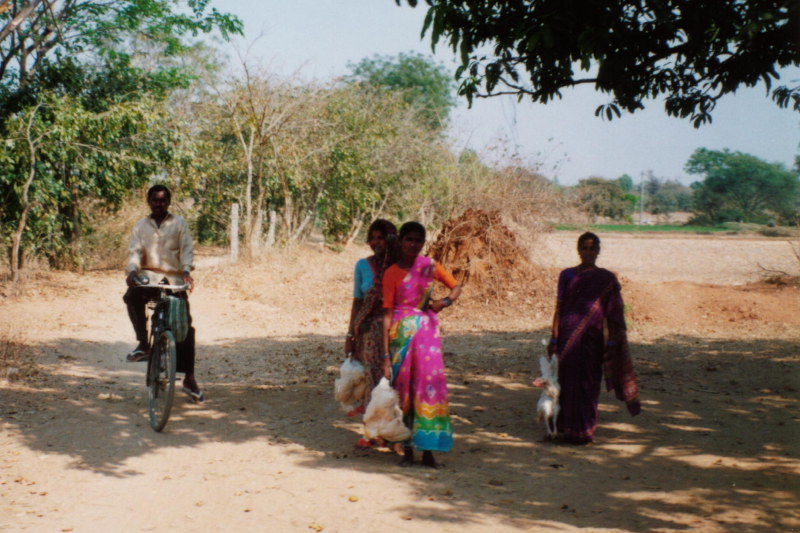Getting to Mysore was an adventure — in a typical Indian transportation kind of way. I showed up at the bus station in Tellicherry early (like always) and had to wait 20 minutes for the bus. I asked around to find out where to wait for the Mysore bus and quickly discovered that everyone else was waiting for the same bus; hundreds of people all mulling around looking for that one teeny tiny metal box on wheels. My stomach dropped when I realized that we’d all be fighting for an inch of space within that metal box and I did a quick inventory of who was carrying pointy objects and sporting bony elbows.
When the bus showed up my prediction was correct: everyone lunged and fought to get onto the bus. This wasn’t like the leisurely pushing and shoving that happens while you are working your way onto the woman’s car on the train; it was rough and dirty fighting done by men desperate to get to their destination without having to sit atop the bus or dangle off the side. At one point I gave up being civilized, realized that I was the biggest one there, plowed through the crowd, onto the bus and moved to the back where I could throw my pack onto the floor and unceremoniously plunk down on top of it.
All the men stared. I don’t mind it when they stare and don’t attempt to touch me. I can just close my eyes and everyone disappears. I learned this trick from Indian women who have a magical way of disappearing to a mysterious place after their eyes are closed.
The roads were excellent between Tellicherry and the first few small towns we traveled past. However, after a while the excellent roads transformed into a crumbling cement path through dense forests that left everyone lurching back and forth and up and down like a cork in the middle of the ocean. The ride was made even more unpleasant when we started creeping along in the heat up into hill country at a speed I could have outdone on my bike.
Finally, after two hours of this we stopped for coconut water and when we got back on the bus a man offered me his seat. I was more than grateful for his kindness and did what any woman in India would do: thanked him and took the seat like it was expected.
The ride after this was considerable better; roads became passable and the scenery became magical. We passed through a forested area that looked like a tribal colony where people lived in small dung huts. Then there was the eerie passage where there were miles of trees with no leaves on them, no birds, and no animals; just the bus and silence. I felt like I was in the middle of a fairy tale but instead of little red riding hood and talking animals the characters were Rama, Sita, and Lakshmana. This made me think of their 14 years in the forest and the hardships they must have faced.
We passed through many a plantation: tea plantations were lush and green, rubber tree plantations were heavily forested and full of people, and coffee plantations were rich. There’s no other word I can think of to describe it. The people who own the coffee own the money. There wasn’t a speck of dirt anywhere, the houses were huge and instead of rudimentary equipment and people power working the fields, the coffee plantations had large scale irrigation systems watering the coffee plants. The coffee beans looked like berries and once picked they lay in the sun to dry; the smell of drying coffee beans completely permeated the air.
Road signs were often entertaining. We traveled through “Accident Area – Ahead” and “Orange Country – Fairy Like.” One of my favourite misspellings managed to weave itself throughout the trip: “bumbs” instead of bumps. Everywhere there were bumps and signs to announce “Watch Out, Bumb Ahead” and “Big Bumb” and “Four Bums in a Row.” I tried to suppress my giggles as we passed each one thinking that no one else would get the joke. Only when we got close to Mysore did the spelling get corrected. Our driver was quite good and rather than whipping through the mountains at breakneck speeds, running people off the roads, and teetering over steep ravines, it was a mellow ride full of bumbs and bumps.
Once out of Kerala the buildings and terrain changed. South India, Kerala, and Tamil Nadu are all lush, green, tropical and very Dutch. Evidence of this and Europe’s influence can be seen in most buildings. Karnataka is Indian. It’s dry, arid, savanna and the buildings are Indian. High palaces and other eye popping sights cover the countryside. I can’t even begin to imagine how much money it took to build the palace in Mysore.
I’m staying in the Ayodhya Lodge in Mysore. My room is an unexpected and excellent surprise. I’m paying 140 rupees ($3.50 CAD) for hot water, air conditioning, and a very comfortable bed. Young boys are running everywhere and are anxious to work, There’s even an old English lift across the hall from my room. I think I’ll stay in Mysore for a while.
